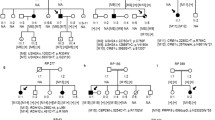Abstract
The molecular diagnosis of retinal dystrophies (RD) is difficult because of genetic and clinical heterogeneity. Previously, the molecular screening of genes was done one by one, sometimes in a scheme based on the frequency of sequence variants and the number of exons/length of the candidate genes. Payment for these procedures was complicated and the sequential billing of several genes created endless paperwork. We therefore evaluated the costs of generating and sequencing a hybridization-based DNA library enriched for the 64 most frequently mutated genes in RD, called IROme, and compared them to the costs of amplifying and sequencing these genes by the Sanger method. The production cost generated by the high-throughput (HT) sequencing of IROme was established at CHF 2,875.75 per case. Sanger sequencing of the same exons cost CHF 69,399.02. Turnaround time of the analysis was 3 days for IROme. For Sanger sequencing, it could only be estimated, as we never sequenced all 64 genes in one single patient. Sale cost for IROme calculated on the basis of the sale cost of one exon by Sanger sequencing is CHF 8,445.88, which corresponds to the sale price of 40 exons. In conclusion, IROme is cheaper and faster than Sanger sequencing and therefore represents a sound approach for the diagnosis of RD, both scientifically and economically. As a drop in the costs of HT sequencing is anticipated, target resequencing might become the new gold standard in the molecular diagnosis of RD.
Access this chapter
Tax calculation will be finalised at checkout
Purchases are for personal use only
Similar content being viewed by others
References
Ma L, Kaufman Y, Zhang J, Washington I (2011) C20-D3-vitamin A slows lipofuscin accumulation and electrophysiological retinal degeneration in a mouse model of Stargardt disease. J Biol Chem 286(10):7966–7974
Escher P, Gouras P, Roduit R, Tiab L, Bolay S, Delarive T et al (2009) Mutations in NR2E3 can cause dominant or recessive retinal degenerations in the same family. Hum Mutat 30(3):342–351
Roduit R, Escher P, Schorderet DF (2009) Mutations in the DNA-binding domain of NR2E3 affect in vivo dimerization and interaction with CRX. PloS One 4(10):e7379
Schorderet DF, Escher P (2009) NR2E3 mutations in enhanced S-cone sensitivity syndrome (ESCS), Goldmann-Favre syndrome (GFS), clumped pigmentary retinal degeneration (CPRD), and retinitis pigmentosa (RP). Hum Mutat 30(11):1475–1485
Zernant J, Kulm M, Dharmaraj S, den Hollander AI, Perrault I, Preising MN et al (2005) Genotyping microarray (disease chip) for Leber congenital amaurosis: detection of modifier alleles. Investig Ophthalmol Vis Sci 46(9):3052–3059
Vallespin E, Cantalapiedra D, Riveiro-Alvarez R, Wilke R, Aguirre-Lamban J, Avila-Fernandez A et al (2007) Mutation screening of 299 Spanish families with retinal dystrophies by Leber congenital amaurosis genotyping microarray. Investig Ophthalmol Vis Sci 48(12):5653–5661
Avila-Fernandez A, Cantalapiedra D, Aller E, Vallespin E, Aguirre-Lamban J, Blanco-Kelly F et al (2010) Mutation analysis of 272 Spanish families affected by autosomal recessive retinitis pigmentosa using a genotyping microarray. Mol Vis 16:2550–2558
Bowne SJ, Sullivan LS, Koboldt DC, Ding L, Fulton R, Abbott RM et al (2011) Identification of disease-causing mutations in autosomal dominant retinitis pigmentosa (adRP) using next-generation DNA sequencing. Investig Ophthalmol Vis Sci 52(1):494–503
Gonzalez-del Pozo M, Borrego S, Barragan I, Pieras JI, Santoyo J, Matamala N et al (2011) Mutation screening of multiple genes in Spanish patients with autosomal recessive retinitis pigmentosa by targeted resequencing. PloS One 6(12):e27894
Simpson DA, Clark GR, Alexander S, Silvestri G, Willoughby CE (2011) Molecular diagnosis for heterogeneous genetic diseases with targeted high-throughput DNA sequencing applied to retinitis pigmentosa. J Med Genet 48(3):145–151
Song J, Smaoui N, Ayyagari R, Stiles D, Benhamed S, MacDonald IM et al (2011) High-throughput retina-array for screening 93 genes involved in inherited retinal dystrophy. Investig Ophthalmol Vis Sci 52(12):9053–9060
Kim C, Kim KJ, Bok J, Lee EJ, Kim DJ, Oh JH et al (2012) Microarray-based mutation detection and phenotypic characterization in Korean patients with retinitis pigmentosa. Mol Vis 18:2398–2410
Neveling K, Collin RW, Gilissen C, van Huet RA, Visser L, Kwint MP et al (2012) Next-generation genetic testing for retinitis pigmentosa. Hum Mutat 33(6):963–972
Schorderet DF, Iouranova A, Favez T, Tiab L, Escher P (2013) IROme, a new high-throughput molecular tool for the diagnosis of inherited retinal dystrophies. BioMed Res Int 2013 (Article ID 198089)
Conflict of Interest
The authors have no conflict of interest.
Author information
Authors and Affiliations
Corresponding author
Editor information
Editors and Affiliations
Rights and permissions
Copyright information
© 2014 Springer Science+Business Media, LLC
About this paper
Cite this paper
Schorderet, D., Bernasconi, M., Tiab, L., Favez, T., Escher, P. (2014). IROme, a New High-Throughput Molecular Tool for the Diagnosis of Inherited Retinal Dystrophies—A Price Comparison with Sanger Sequencing. In: Ash, J., Grimm, C., Hollyfield, J., Anderson, R., LaVail, M., Bowes Rickman, C. (eds) Retinal Degenerative Diseases. Advances in Experimental Medicine and Biology, vol 801. Springer, New York, NY. https://doi.org/10.1007/978-1-4614-3209-8_22
Download citation
DOI: https://doi.org/10.1007/978-1-4614-3209-8_22
Published:
Publisher Name: Springer, New York, NY
Print ISBN: 978-1-4614-3208-1
Online ISBN: 978-1-4614-3209-8
eBook Packages: MedicineMedicine (R0)




